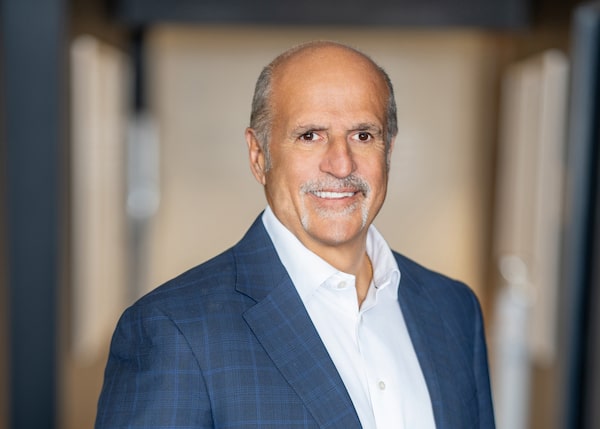
KP Tissue's Chief executive Dino Bianco says managing margins with rising pulp prices and driving continued growth will be critical to the company in 2024.Handout
While some people may not be familiar with the stock KP Tissue Inc. KPT-T, many have this company’s products in their homes and recognize its leading brands, including Cashmere, Scotties and SpongeTowels. Last week, KP Tissue reported record revenue and adjusted EBITDA (earnings before interest, taxes, depreciation and amortization) for 2023. Yet the share price has been under pressure, posting a double-digit decline over the past five months despite an attractive dividend yield of more than 8 per cent.
The Globe and Mail recently spoke with chief executive Dino Bianco to discuss management’s goals, key risks and his read on the economy.
How would you prioritize your strategic objectives for 2024?
Being able to manage our margins with pulp starting to go up is going to be critical. Second, we need to continue to drive our growth curve. We spent over a billion dollars in the last couple of years, so being able to continue to drive sales to utilize those assets is going to be critical. The third one is continuing to build our brands.
How long is the development process from idea generation through to production, and what’s your pipeline of potential new products?
There are different types of innovation. There’s simple stuff like a Scotties [tissue] box with the Toronto Maple Leafs logo on it – that’s innovation. We can get that turned around within six months. There’s new innovation that says we need production, we need to test markets, we need to create a new brand. Those types of innovations are generally two- to three-year pipelines.
As it relates to the innovation, let me tell you a few vectors that are really important. One is sustainability. We did launch a Bonterra brand two years ago. We will continue to build sustainability credentials, not just in the product but in the packaging and the way it’s made. The other vector is on-the-go. Consumers use tissue outside of the home, particularly with facial. The third vector is with quality differentiation. We have new assets now that produce the best quality products, so doing more at the high end of the scale – softer, more absorbent types of products – we’ll grow that.
Adjacency would be another area that we would look at, areas near tissue that consumers are using and an easy move for our brands to make into a sector that’s very close to the sector that we are already in.
Like what?
Wipes, paper towels that may include a cleaner in it – that would be a vector in this space.
Do you have the capacity to explore all these potential opportunities? On the recent earnings call, you said, “Everything we’re making, we’re basically selling,” which made me think you are running at full capacity.
The industry is so capital-intensive. You want to run them at high utilization rates right from the start, which is very different from when I worked in the food business, which was very capital-intensive, but we always had headroom in the capacity to be able to deal with surges. In this industry, you’re running all out, all the time. Once you get up to full capacity, you have to put new assets in.
We’ve just added a billion dollars of assets. We put two new facial lines in. We’re putting a new paper machine in – that’s going to be a full-size machine that will start up in quarter four of this year. We put in a new bathroom tissue line earlier in 2023. We continue to add assets.
I want to turn to your largest cost, pulp. On the recent conference call, you said the largest wild card is pulp pricing. You expect pulp prices to increase in 2024.
Pulp, it’s a very complicated global market. My comment on pulp going up is not my opinion. We use global experts who tell us what is going on with pulp.
Do you lock in pulp prices for a certain length of time to reduce your exposure to fluctuations in pulp pricing?
Generally, we’ll lock in our quantities. We give it a range, so lock 80 per cent of the quantity in and we’ll have flexibility on 20 per cent in case there’s any changes, and it varies by contract. We do some one-year contracts, we do some two-year contracts. We even, I think, have some three-year contracts.
Pricing is usually a mechanism that’s tied to a market indicator, so they do move, there’s never a guaranteed price. What we do guarantee is our discount to those prices. Generally, in the pulp market, you tend to negotiate a discount to a list price that will stay throughout the curve.
Inflation has caused consumers to shift away from branded products and trade down to private label. How are you navigating this trend?
The beauty of our company is we have every size, every format. We have the entry-level tissue right up to the premium end. We have brands, we have private label, so we have a fairly good diversification strategy that helps us – it doesn’t totally offset it. Last year, we did lose share when consumers traded down, but it could have been a lot worse if we were only a branded company. And this year, we’re building share through investments and managing price gaps.
Your Away-From-Home business segment has a diversified customer base – food service, lodging, etc. As such it gives you a good read on the economy. What differences are you seeing between Canada and the U.S., the two countries that you operate in?
I would say, even though neither country is in a recession, I think Canadians are probably a little more guarded, watching to see where [the economy] is going. We just have to keep an eye on this because if people stop going out or stop eating at restaurants or staying at hotels, that sector will feel it, and we get a greater sense of that worry in Canada right now. I would not say we’ve seen anything dramatically shift, but I just can tell by the dialogue that we’re having with some of our customers that they’re just keeping an eye on this, watching it, more so in Canada than in the U.S.
How can you offset higher pulp prices to maintain your margins?
There’s probably a few ways. The most obvious is trying to price the business to staying close to the cost curve, which we do. The second thing we do is we have productivity challenges every year. We try to take savings out of the product without touching quality. We will do what we can either in production or in the product design that will try to reduce cost. And then the third area is if we can move our portfolio more to higher-margin products, some of the premium products. But the most effective way is through pricing and staying close to the cost curve.
Over the past 10 years, your adjusted EBITDA margin has been roughly around 11 per cent, 12 per cent. In 2023, it was 12.7 per cent. Do you see the margin remaining around this level?
I think we have room to grow. One of the big reasons is that our Away-From-Home business is turning around. I’ve said to the street that that margin should be 5 to 10 per cent. Our Consumer business trades a little higher, and the more we can move to our brands and to premium products, we should see an accretion in our margins. We were at 12.7 per cent last year, I would say we’ll be in the low teens. Does that mean we’re going to be 12.5, 13.5 or 14 per cent? I don’t know. But our goal is to obviously continue to move the business in an accretive way, and some of these new assets should contribute a better margin structure to our overall business.
Since 2019 you have added around 300 people and currently have approximately 2,800 employees.
Part of it is because we’ve become a bigger company, we’re almost at $2-billion in sales. A lot of that growth that you’re seeing is in the fact that we added new plants. And we have been also adding in the area of AI technology and analytics, trying to modernize our business. They aren’t big numbers but they’re new headcount that we wouldn’t have had years ago to make sure that we’re ready for the transformation that’s going on in manufacturing.
In your 2022 annual report, it said you invested in artificial intelligence, AI technology, at your Sherbrooke plant to “maximize reliability and uptime.” Was that your first foray into AI, and do you plan to make AI investments at your other facilities?
Yes, that was the first time we used AI and predictive technology, and we did it at the new plant because we had the best equipment that had all the data capture capability available to us. We were able to get the data and then we were able to use that data to be more predictive. We did see significant improvements. They certainly allowed us to, I won’t say necessarily automate, but certainly be more predictable. We have analytics telling us what we should do to optimize our recipe, if you will.
Now we’re rolling it out at our Memphis facility and then we’ll start rolling it out at all the other sites as well. It’s a big investment. We don’t have hundreds of people doing it, so you’ve got to do it judiciously and pick your spots and then prove and learn and then go to the next location.
When reading through your financial reports, I was surprised to learn that you source your fibre from Canada – and also Brazil.
There’s two types of pulp. One type of pulp is called softwood. It generally comes from Canada and it provides the hardness, the strength of the products, because it’s got long fibres. Then we use a hardwood. Even though it says hardwood, it actually provides softness, and it’s shorter fibres, mainly eucalyptus trees. Most of the major suppliers of eucalyptus are out of Brazil.
How would you describe the competitive landscape right now?
In the Canadian marketplace, there’s really three major players. There’s us, Irving and Cascades, so it’s a small pool. I think the market is fairly well behaved, but that could change at any time. Right now, I think capacity utilization in this industry is high, which helps the market be a little more predictable.
You’re a market leader, you have record financial results, you have diversified product offerings, you have a stable dividend, yet your share price is under pressure.
We don’t have a large float, so sometimes things can drive the stock price quicker because it’s a fairly small float. The second thing I would say is that there’s nothing going on – everything we press release, everything is on SEDAR, everything available. There aren’t any worries that we have that haven’t been communicated to the market. It is what it is. I’m not happy where it is, but these things go in cycles. The fundamentals of the company are there and, as you said, the dividend is there.
Be smart with your money. Get the latest investing insights delivered right to your inbox three times a week, with the Globe Investor newsletter. Sign up today.
 Jennifer Dowty
Jennifer Dowty